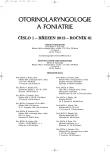Comparison of Singer Techniques in Unaccompanied and Choral Singing
Authors:
M. Lejska 1; R. Havlík 1; M. Frič 2
; A. Priechodská-Široká 3
Authors‘ workplace:
AUDIO-Fon centr., Brno
1; Výzkumné centrum hudební akustiky (MARC) AMU, Praha
2; Národní divadlo Brno
3
Published in:
Otorinolaryngol Foniatr, 61, 2012, No. 1, pp. 44-52.
Category:
Original Article
Overview
In the area of artistic singing the unaccompanied singers - soloists are artistically and socially preferred to other singers. There are, however, highly artistically and professionally performing choirs, where the members – singers – are burdened with at least the same vocal load as soloists.
It cannot be doubted that the area of the highest singer skills includes both soloists and choral singers. Nevertheless, their artistic expression differs significantly, although both groups use signing for the display. If the singer manifestation differs, which is common then the singer technique and consequently the load and related voice disorders differ as well and bring the singers of both groups into phoniatric outpatient departments. This view is important for finding, recognition, and evaluation of differences between the soloist and choral singing.
The contribution compares the recordings of the same singer singing identical part by the soloist and choral technique, respectively. The processing used the methods of musical acoustics. The results confirmed the presumption that the soloist singing differs from the choral one. The highest differences were found in the intensity of the singer’s effort and its frequency structure. In the examples of soloist singing the areas of higher harmonic tones are more illuminated which make the voice more inspiring with more expressed individuality.
If the signs of affected voice become obvious, the higher phoniatric care should be provided to soloist as well as choral singers.
Key words:
soloist singer technique, choral singer technique, musical acoustics, phoniatric care.
Sources
1. Carter, B. B.: An acoustic comparison of voice use in solo and choir singing in under graduate and graduate student singers (2007). http://repositories.lib.utexas. edu/bitstream/handle/2152/3552/carterd37835.pdf?sequence=2
2. Cole, S. Thomas, T. and his Music in Victorian England. Woodbridge, UK: Boydell, 2008.
3. Dylan, J. M.: The choral voice is very different to the soloistic voice. http://mixmargaret.com/choir-singers.html
4. Eby, K. In Gloss, M.: Choral singing and solo technique. From the teacheręs perspective. Classical Singer, 2009, March, 14-18.
5. Gloss, M. : Choral singing and solo technique. From the teacher’s perspective. Classical Singer, 2009, March, 14-18.
6. Choir : Wikipedia 2011. http://en.wikipedia.org/wiki/Choir
7. KayPENTAX: Multi-Dimensional Voice Program (MDVP), Model 5105, 2008.
8. Lee, S. H., Kwon, H. J., Choi, H. J., Lee, N. H., Lee, S.J., Jin, S. M.: The Ssnger’s formant and speaker’s ring resonance: A long-term average spectrum analysis. Clin. Exp. Otorhinolaryngol., 1, 2008, 2, s. 92-96.
9. Miller D. G., Schutte H. K.: Formant tuning in a proffesional baritone. Journal of Voice, 4, 1990, 3, s. 231-237.
10. Nordenberg, M. et al.: Effect on LTAS of vocal loudness variation. Logopedics Phoniatrics Vocology, 29, 2004, 4, s. 183-191.
11. Omori, K., Kacker, A., Carroll, L. M., Riley, W. D., Blaugrund, S. M.: Singing power ratio: quantitative evaluation of singing voice duality. J. Voice, 10, 1996, 3, s. 228-235.
12. Reid, K. L., Davis, P., Oates, J., Cabrera, D., Ternstrom, S., Black, M., Chapman, J.: The acoustic characteristics of professional opera singers performing in chorus versus solo mode. J. Voice, 21, 2007, 1, s. 35-45.
13. Rossing, T. D., Sundberg, J., Ternstrom, S.: Acoustic comparison of voice use in solo and choir singing. J Acoust. Soc. Am., 79, 1986, 6, s. 1975-1981.
14. Rossing, T. D., Sundberg, J., Ternstrom, S.: Acoustic comparison of soprano solo and choir singing. J. Acoust. Soc. Am., 82, 1987, 3, s. 830-836.
15. Sundberg, J., Nordenberg, M.: Effects of vocal loudness variation on spectrum balance as reflected by the alpha measure of long-term-average spectra of sérech. J. Acoust.Soc. Am., 120, 2006, 1, s. 453-457.
16. Štěpánek, J., Otčenášek, Z.: Acoustical correlates of the main features of violin timbre perception, Electronic proceedings of CIM05 Montréal 2005, Québec, Canada.
17. Švec, J. G., Herbst, C., Havlík, R., Horáček, J., Krupa, P., Lejska, M., Miller, D. G.: SINGER’S FORMANT: Prelimitary results of MRI and acoustic evaluations of singers. Interaction and feedbacks 2008, Institute of Thermomechanics AS CR, November 25 - 26, 2008.
18. Ternström, S.: Long-time average spectrum characteristics of different choirs in different rooms, Speech, Music and HearingQuarterly Progress and Status Report, 30, 1989, 3, s. 15-31.
19. Ternström, S.: Choir acoustics: An overview of scientific research published to date. International Journal of Research in Choral Singing, 1, 2003, 1, s. 1-8.
20. Thomas, A., Penderecki, K.: ‘The New Grove Dictionary of Opera‘‘, ed. Stanley Sadie (London, 1992) ISBN 0-333-73432-7.
Labels
Audiology Paediatric ENT ENT (Otorhinolaryngology)Article was published in
Otorhinolaryngology and Phoniatrics

2012 Issue 1
Most read in this issue
- What Treatment for the “Dry” Nose?
- Pharyngitis Caused by Streptococcus Pyogenes
- Bleeding after Tonsillectomy and Tonsillotomy in Children
- Translabyrinth Craniotomy for Removal of Vestibular Schwannoma
